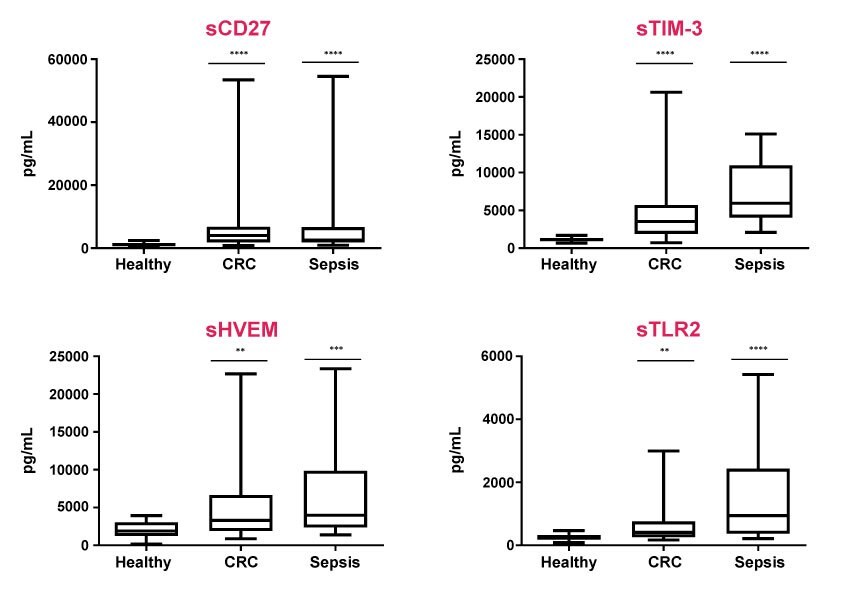Multiplex Cancer Assays: Advance Research with Cancer Biomarker Detection

To advance cancer research, reliable cancer biomarker detection is key. Read on to see how MILLIPLEX® multiplex cancer assays are advancing various cancer research areas including lung cancer, breast cancer, and immuno-oncology research.
Section Overview
What Are Cancer Biomarkers?
A tumor marker, or biomarker, is a molecular entity whose relative quantity or localization is different between tumor-bearing and non-tumor-bearing subjects. Understanding what cancer biomarkers and their detection are is important not only for therapeutic use but also because they can be used to decipher the signaling pathways underlying both normal and diseased cellular processes. Multiplexed detection of circulating cancer markers can accelerate studies of normal homeostasis and tumorigenic processes.
How Multiplex Assays Advance Cancer Research
Detection of isolated protein biomarkers is often inadequate to distinguish tumor from non-tumor. Multiplexed detection of both intracellular and circulating cancer markers through multiplex assays can accelerate studies of normal homeostasis and tumorigenic processes, as long as your assays exhibit accuracy and lot-to-lot consistency.
Using the bead-based Luminex® xMAP® platform, the MILLIPLEX® cancer portfolio provides a broad offering of multiplexed cancer marker assays, compatible with serum, plasma, tissues, cultured cells, and other biological samples. These analytically verified kits and assays enable you to measure specific proteins in cancer research areas.
The wide-ranging cancer multiplex panel offering includes kits to measure cancer biomarkers, checkpoint proteins, as well as cytokines, chemokines, and growth factors. Some popular cancer biomarkers from these panels are listed in Table 1.
Applications of Multiplexing Cancer Biomarkers
There are many applications of multiplexing cancer biomarkers. Below describes how MILLIPLEX® multiplex assays are being used in immuno-oncology research, lung cancer research, and more.
Immuno-Oncology Research
In immuno-oncology research, immune checkpoint inhibitors have been proven to be an effective method in improving anti-tumor immune response. Many immune checkpoint proteins are expressed as soluble forms in circulation and in the tumor and tumor microenvironment.
Multiplex assays can be used for the quantitative profiling of co-inhibitory and co-stimulating immune checkpoint proteins. For example, they can be used to explore the use of soluble immune checkpoint proteins as putative cancer biomarkers. The MILLIPLEX® Human Immuno-Oncology Checkpoint Protein Panel 1 immuno-oncology multiplex assay was used to measure checkpoint protein levels in serum samples from breast cancer, colon cancer, and a corresponding set of normal serum samples.
Analysis of the soluble checkpoint protein signatures generated from this multiplex approach revealed 2 putative circulating cancer biomarkers: TIM-3 and LAG-3. A significantly elevated level of soluble TIM-3 protein in the breast cancer serum samples and the colon cancer serum samples compared to the healthy serum controls (p<0.001) was observed. LAG-3 was also elevated in human breast cancer sera when compared to the expression levels in sera from healthy controls (data not shown).
In addition, this panel was used to analyze the immune checkpoint protein expression profiles in lysates of tumor and adjacent normal tissues from 3 samples with metastatic breast cancer and 2 samples with colorectal cancer (data not shown). Differential expression of multiple checkpoint proteins, including BTLA, CD27, TIM-3, HVEM, CD40, GITR, LAG-3, CTLA-4, CD80/B7-1, PD-L1, or ICOS, were detected in these matched lysates, indicating the roles and complexity of checkpoint proteins in the tumor microenvironment.
These results demonstrate that multiplex assays are useful research tools for the simultaneous quantitation of immune checkpoint proteins, as well as their potential application in cancer biomarker discovery and translational research in cancer immunotherapy.
See how MILLIPLEX® assays were also used to correlate biomarkers in peripheral blood samples of nivolumab with or without tadalafil in resectable squamous cell carcinoma of the head and neck (SCCHN) research.
Lung Cancer Research
One research area that has benefitted from immuno-oncology agents is lung cancer. Multiplexing allows researchers to evaluate multiple biomarkers related to lung cancer at once to find correlations and gain a deeper understanding of cancer processes. For example, multiplex cancer panels have been used to:
- Correlate angiogenesis biomarkers with early metastatic progression in NSCLC
- Understand the PD-1/PD-L1 pathway in NSCLC by multiplexing immune checkpoints in immunotherapy samples
Learn more about how researchers at Rush University Medical Center are developing novel tests for NSCLC through their research with MILLIPLEX® assays in this editorial article.
Breast Cancer Research
Immune regulators, including immune checkpoint proteins and cytokines/chemokines, have an emerging role as both disease/treatment biomarkers and targeted agents in cancer therapies. To contribute to the understanding of the roles of these immune regulators in cancer, three Luminex®-based multiplex immunoassay panels were developed, a 48-plex human cytokine/chemokine panel, a 17-plex human immune checkpoint protein panel, and a 31-plex human immune checkpoint protein panel. Multiplex assays contribute to the understanding of the roles of these immune regulators in breast cancer by simultaneously quantitating the expression levels of key immune regulator proteins in biofluids or cell/tissue homogenates.
The MILLIPLEX® Human Immuno-Oncology Checkpoint Protein Panel 1 and Panel 2 immuno-oncology multiplex assays and the MILLIPLEX® Human Cytokine/Chemokine/Growth Factor Panel A immunology multiplex assay were used to profile 95 immune regulators in 3 types of breast cancer samples: cancer versus healthy control serum samples, lysates from breast cancer tumor biopsies versus adjacent normal tissues, and conditioned media from established cancer cell lines. Analysis of the circulating immune protein signatures generated from this multiplex approach revealed elevated levels of IL-6, IL-27, M-CSF, MDC, MIG, sCD27, sTIM-3, sCD40, Galectin-3, Galectin-1, FGL-1, BAFF, and low levels of EGF and sCD40L in breast cancer serum samples compared to the healthy serum controls (select analytes shown in Figure 1).

Figure 1.Examples of the use of these immuno-oncology multiplex immunoassays for detecting soluble immune checkpoint proteins and cytokines/chemokines in sera from breast cancer (breast cancer samples (BrCa) in red, n=24) and healthy control individuals (control samples (Cont) in blue, n=24). The figure shows differential expression of 6 cancer-immunity biomarkers (IL-6, MIG, IL-27, TIM3, Gal-1, FGL1) in these two groups of serum samples. All have p-values <0.0001.
The expression profiling of tumor and adjacent normal tissues from 3 samples with metastatic breast cancer revealed differential expression of multiple protein markers including IL-6, IL-8, MIG, IL-1RA, IL-18, IP-10, MCP-1, MIP-1β, VEGF-A, BTLA, HVEM, CTLA-4, CD40, TLR-2, Siglec-9, CD25, Granzyme B, APRIL, BAFF, Nectin-2, Nectin-4, E-cadherin, and IDO-1 in the matched lysates. A similar analysis was also performed using the conditioned media of cultured breast tumor cells. Altogether, results suggested Luminex®-based profiling allowed for sensitive and versatile multiplexed analysis of stimulating and inhibitory immune mediators in circulation, tissues, and cell lines which may assist in the discovery of biomarkers and therapeutic targets for breast cancer interventions.
Colorectal Cancer Research
In recent years, targeting immune checkpoint proteins is an innovation for the treatment of cancer and immune-related adverse events. Many checkpoint molecules have been identified on immune cells and/or tumor cells as activating receptors or inhibitory receptors. Many immune checkpoint proteins are also expressed as soluble forms in circulation, easily accessible as potential biomarker candidates.
Multiplex assays provide quantitative profiling of co-inhibitory and co-stimulating immune checkpoint proteins related to colon cancer. For example, the MILLIPLEX® Human Immuno-Oncology Checkpoint Protein Panel 1 immuno-oncology multiplex assay was used to investigate a potential role for serum circulating immune checkpoint proteins as putative biomarkers in colorectal cancer (CRC) and sepsis samples. Multiple checkpoint protein expression levels were measured in serum samples from CRC (n=20), sepsis (n=20), and a corresponding set of normal serum samples (n=20).
Analysis of the soluble checkpoint protein signatures generated from this multiplex approach revealed differential expression of 9 soluble forms of proteins, sBTLA, sCD27, sTIM-3, sHVEM, sCD40, sPD-1, sPD-L1, sCD86, and sTLR-2, in the CRC or sepsis serum samples, compared to the healthy serum controls (select analytes shown in Figure 2).

Figure 2.MILLIPLEX® Human Immuno-Oncology Checkpoint Protein Panel 1 was performed in a 96-well plate. The figure shows differential expression of 4 soluble biomarkers (sCD27, sTIM-3, sHVEM, and sTLR2) in colorectal cancer (CRC), sepsis, or healthy/control samples. GraphPad Prism was used to create box plots and the Mann-Whitney test was used for statistical analyses. **p<0.01; ***p<0.001; ****p<0.0001.
This demonstrated that cancer multiplex immunoassays are useful for the simultaneous quantitation of circulating immune checkpoint proteins related to CRC and sepsis.
Learn more about MILLIPLEX® assays in our Overview of Luminex® Multiplex Assay Technology article.
Checkpoint Protein Markers
Circulating Tumor Markers
Angiogenesis
Metastasis
Cancer Autoantibodies
For Research Use Only. Not For Use In Diagnostic Procedures.
To continue reading please sign in or create an account.
Don't Have An Account?